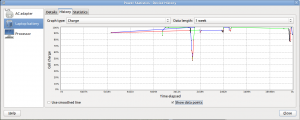Surprisingly enough, it seems that GNOME Power Manager does not handle time paradoxes properly. If you run GNOME on a DeLorean or have your computer clock go back in time, it seems that g-p-m’s statistics does not take this into account, and draws… interesting graphs:

I was about to file a bug report on this (honestly!), but then realized that time travel would probably not fit in GNOME3’s vision. Besides, GNOME Shell currently doesn’t run on my DMC-12 because of a bug in the Mr. Fusion drivers, apparently.
Comments
9 responses to “88 watts per hour1 min read”
So what *do* you expect the graph to show in the event that your computer travels backward in time (or more mundanely, someone messes with the clock)?
Or maybe if you travel a lot? Fly from Toronto to Vancouver would be misinterpreted as time travel by the computer.
@Simon: Good question. If someone actually considers this a genuine bug, I guess one possible “solution” would be to exclude data points that are timestamped older than the previous existing data point… (But do note that the main intent of my blog post was to be humorous. I just thought this was funny, otherwise I guess I’d really have filed a bug 😉
@Arthur: Hmm. I hadn’t initially thought of the “flying in a plane and crossing timezones” use case (or daylight savings time too, perhaps). Interesting.
> @Arthur: Hmm. I hadn’t initially thought of the “flying in a plane and crossing timezones” use case (or daylight savings time too, perhaps). Interesting.
Which, in turn, turns this issue into a real bug.
Patches welcome! 🙂
Your title has a bug too, as 1 Watt = 1 Joule / second. So that’s 88 Watts x 1 hour, not per hour… :-p
@liberforce: damn 🙂 but the title wasn’t exactly meant to be accurate either. Realistically, my laptop doesn’t consume “watts per hour” (nor does it consume 88 watts, period).
Or, 88Whr (Watt Hours)…
10W/h = (10J/s)/h = (10J/s)*(1/3600s) = 10J/3600s^2 (or, 10J/s/h)
10W*h = (10J/s)*h = 10J*h/s = 10J*3600s/s = 36000J
With the first, in one hour you’d be using 10J/s; in two hours, 20J/s… (don’t ask me the number of Joules, don’t feel like pulling out my physics notes, atm). Basically, you wouldn’t be able to use your laptop after a few hours, regardless of your battery’s capacity. 😉
With the second, in one hour you will have used 36000J; in two hours, 72000J.
You guess one possible solution would be to exclude data points that are timestamped older than the previous existing data point…
Another solution (one that I would prefer) is to make the x-axis reflect the clock-readjustment-or-backwards-time-travel. If a data point has a later timestamp than a following data-point, e.g. 2:30 pm followed by 2:10 pm, then the x-axis should include the period in between (2:10 to 2:30) twice successively. This way, all data points can be plotted in chronological order (where chronologic refers to actual time, not clock time).